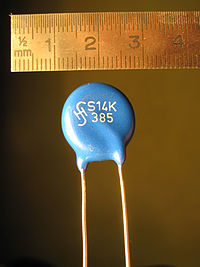
Photo from wikipedia
Near-threshold and sub-threshold voltage designs have been identified as possible solutions to overcome the limitations introduced by energy consumption in modern very large scale integration circuits. However, as we approach… Click to show full abstract
Near-threshold and sub-threshold voltage designs have been identified as possible solutions to overcome the limitations introduced by energy consumption in modern very large scale integration circuits. However, as we approach sub-10 nm transistor technology, aggressive voltage, and gate length scaling will reduce the reliability of logic circuits due to the increasing impact of noise and variability effects. Therefore, designers need new tools to simulate logic circuits in the presence of noise. Time-domain analysis helps understand how transient faults affect a circuit and can guide designers in producing noise-resistant circuitry. However, standard approaches to modeling intrinsic noise sources in the time domain are computationally expensive. Moreover, small noise-driven fluctuations in electron occupation of circuit nodes introduce time-varying biasing point fluctuations, increasing the modeling complexity. To address these challenges, this paper introduces a new approach to modeling thermal noise and random telegraph signal noise directly in the time domain by developing and solving a series of stochastic differential equations. In comparisons to traditional SPICE-based simulations, our approach can provide three orders of magnitude speedup in simulation time without sacrificing accuracy. Moreover, we introduce a novel, iterative threshold-crossing algorithm, aimed at the efficient sampling of rare noise transients. We show that Monte-Carlo simulations based on this approach can detect rare high-amplitude single event transients that would be impossible to uncover with standard transient simulators.
Journal Title: IEEE Transactions on Computer-Aided Design of Integrated Circuits and Systems
Year Published: 2018
Link to full text (if available)
Share on Social Media: Sign Up to like & get
recommendations!